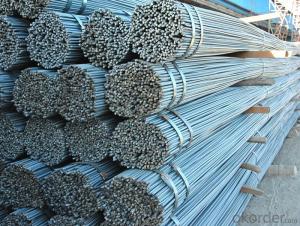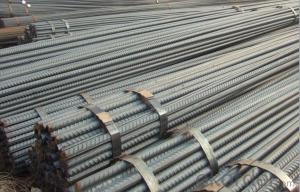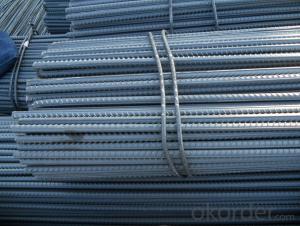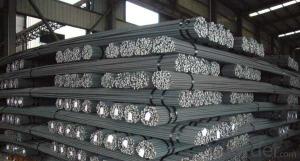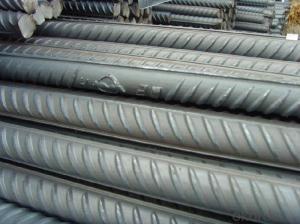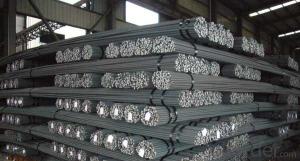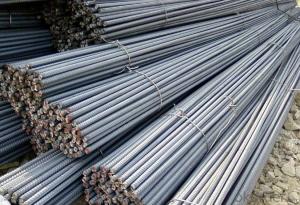Hot rolled high quality deformed bar 10-50mm
- Loading Port:
- Tianjin
- Payment Terms:
- TT OR LC
- Min Order Qty:
- 25 m.t.
- Supply Capability:
- 25000 m.t./month
OKorder Service Pledge
OKorder Financial Service
You Might Also Like
Deformed Bar Details:
| Minimum Order Quantity: | Unit: | m.t. | Loading Port: | ||
| Supply Ability: | Payment Terms: | Package: | wire rod packing |
Product Description:
Product Description:
Specifications of HRB400 Deformed Steel Bar:
Standard | GB | HRB400 | |
Diameter | 6mm,8mm,10mm,12mm,14mm,16mm,18mm,20mm, 22mm,25mm,28mm,32mm,36mm,40mm,50mm | ||
Length | 6M, 9M,12M or as required | ||
Place of origin | Hebei, China mainland | ||
Advantages | exact size, regular package, chemical and mechanical properties are stable. | ||
Type | Hot rolled deformed steel bar | ||
Brand name | DRAGON | ||
Chemical Composition: (Please kindly find our chemistry of our material based on HRB500 as below for your information)
Grade | Technical data of the original chemical composition (%) | ||||||
C | Mn | Si | S | P | V | ||
HRB400 | ≤0.25 | ≤1.60 | ≤0.80 | ≤0.045 | ≤0.045 | 0.04-0.12 | |
Physical capability | |||||||
Yield Strength (N/cm²) | Tensile Strength (N/cm²) | Elongation (%) | |||||
≥400 | ≥570 | ≥14 | |||||
Theoretical weight and section area of each diameter as below for your information:
Diameter(mm) | Section area (mm²) | Mass(kg/m) | Weight of 12m bar(kg) |
6 | 28.27 | 0.222 | 2.664 |
8 | 50.27 | 0.395 | 4.74 |
10 | 78.54 | 0.617 | 7.404 |
12 | 113.1 | 0.888 | 10.656 |
14 | 153.9 | 1.21 | 14.52 |
16 | 201.1 | 1.58 | 18.96 |
18 | 254.5 | 2.00 | 24 |
20 | 314.2 | 2.47 | 29.64 |
22 | 380.1 | 2.98 | 35.76 |
25 | 490.9 | 3.85 | 46.2 |
28 | 615.8 | 4.83 | 57.96 |
32 | 804.2 | 6.31 | 75.72 |
36 | 1018 | 7.99 | 98.88 |
40 | 1257 | 9.87 | 118.44 |
50 | 1964 | 15.42 | 185.04 |
Usage and Applications of HRB400 Deformed Steel Bar:
Deformed bar is widely used in buildings, bridges, roads and other engineering construction. Big to highways, railways, bridges, culverts, tunnels, public facilities such as flood control, dam, small to housing construction, beam, column, wall and the foundation of the plate, deformed bar is an integral structure material. With the development of world economy and the vigorous development of infrastructure construction, real estate, the demand for deformed bar will be larger and larger..
Packaging & Delivery of HRB400 Deformed Steel Bar:
Packaging Detail: products are packed in bundle and then shipped by container or bulk vessel, deformed bar is usually naked strapping delivery, when storing, please pay attention to moisture proof. The performance of rust will produce adverse effect.
Each bundle weight: 2-3MT, or as required
Payment term: TT or L/C
Delivery Detail: within 45 days after received advanced payment or LC.
Label: to be specified by customer, generally, each bundle has 1-2 labels
Trade terms: FOB, CFR, CIF
- Q: Are steel rebars suitable for reinforcement in parking garages?
- Yes, steel rebars are suitable for reinforcement in parking garages. Steel rebars provide the necessary strength and durability to support the weight of vehicles and withstand the various loads and stresses experienced in parking garage structures.
- Q: Are steel rebars susceptible to rust?
- Steel rebars can be easily affected by rust. Typically composed of carbon steel, rebars contain iron. When they come into contact with moisture and oxygen, the iron reacts and forms rust, also known as iron oxide. The presence of salt or other corrosive materials speeds up this process. The weakening of rebars due to rust formation can eventually cause structural harm if not addressed. Hence, it is vital to safeguard steel rebars by applying a suitable coating or utilizing alternative methods of corrosion prevention. This measure guarantees the durability and structural soundness of reinforced concrete structures.
- Q: How are steel rebars stored on site to prevent damage?
- Steel rebars are typically stored on site in a well-organized manner, ensuring they are protected from damage. They are usually placed on elevated racks or pallets to prevent contact with the ground and potential moisture. Additionally, rebars are stored horizontally and separated by wooden spacers to prevent corrosion and tangling. Lastly, they are often covered with a tarp or plastic sheeting to shield them from rain or other environmental factors that could cause damage.
- Q: Can steel rebars be used in structures with limited maintenance access?
- Yes, steel rebars can be used in structures with limited maintenance access. Steel rebars are commonly used in construction due to their durability and strength. They can withstand various environmental conditions and require minimal maintenance. Additionally, their flexible and versatile nature allows them to be easily integrated into structures with limited maintenance access, making them a suitable choice for such projects.
- Q: What is the average lifespan of a reinforced concrete structure with steel rebars?
- The average lifespan of a reinforced concrete structure with steel rebars can vary depending on various factors such as design, construction quality, environmental exposure, and maintenance. However, with proper design, construction practices, and regular maintenance, reinforced concrete structures with steel rebars can typically last for several decades or even over a century.
- Q: What are the factors to consider while choosing the right type of steel rebar for a project?
- When choosing the right type of steel rebar for a project, several factors need to be considered. These factors include the grade and quality of the steel, the required strength and durability, the environmental conditions of the project site, the structural design and specifications, the budget, and any specific regulations or standards that need to be followed. Additionally, factors such as corrosion resistance, weldability, and availability of the steel rebar should also be taken into account. Overall, a comprehensive analysis of these factors will help in selecting the most suitable steel rebar for the project.
- Q: What is the process of galvanizing steel rebars?
- The process of galvanizing steel rebars involves the application of a layer of zinc to the surface of the rebar in order to prevent corrosion and prolong its lifespan. The process typically consists of the following steps: 1. Surface Preparation: The steel rebars are cleaned thoroughly to eliminate any dirt, oil, or scale from the surface. This is typically achieved through the use of chemical cleaning agents and mechanical methods, such as sandblasting or shot blasting. 2. Pickling: Once cleaned, the rebars are submerged in a pickling solution, usually a mixture of hydrochloric acid and water. This solution eliminates any remaining impurities or oxides from the surface of the rebars. 3. Fluxing: The pickled rebars are then rinsed to eliminate any residual acid and are immersed in a flux solution. The flux solution aids in the removal of any remaining oxides and ensures proper adhesion of the zinc coating. 4. Galvanizing: The fluxed rebars are then dipped into a molten zinc bath. The temperature of the zinc bath is typically kept between 815 to 850 degrees Fahrenheit (435 to 455 degrees Celsius). The rebars are carefully immersed and then slowly withdrawn to allow excess zinc to drain off. 5. Quenching: After the galvanizing process, the rebars may be rapidly cooled in a specialized solution to stabilize the zinc coating. This step helps to prevent the excessive formation of zinc oxide on the surface. 6. Inspection: Once the galvanized rebars have cooled down, they undergo a comprehensive inspection to ensure the quality of the coating. Visual inspection, thickness measurement, and adhesion tests are commonly conducted to assess the integrity of the zinc coating. Overall, the galvanizing process provides a robust and effective protective coating for steel rebars, rendering them highly resistant to corrosion and extending their lifespan in a variety of applications, including construction, reinforcement, and infrastructure projects.
- Q: Are steel rebars suitable for reinforcement in historical monuments?
- Steel rebars may not be suitable for reinforcement in historical monuments. The use of steel rebars can cause damage to the structural integrity and aesthetics of these monuments. Traditional materials and techniques that are compatible with the existing structure should be considered instead, to ensure the preservation and authenticity of these historical sites.
- Q: What are the guidelines for the proper anchoring of steel rebars in walls?
- The proper anchoring of steel rebars in walls is crucial to ensure the structural integrity and stability of the construction. Here are some guidelines to follow for the correct anchoring of steel rebars in walls: 1. Determine the required rebar size and spacing: The size and spacing of rebars depend on the design specifications and load requirements. Consult the structural engineer or refer to the building codes for the appropriate rebar size and spacing. 2. Clean and prepare the concrete surfaces: Before anchoring the rebars, ensure that the concrete surfaces are clean, free from dust, debris, and any loose material. Use a wire brush or compressed air to remove any contaminants. 3. Use proper anchoring techniques: The most common method for anchoring steel rebars in walls is by embedding them into the concrete. Ensure that the rebars are securely embedded by following these steps: a. Drill holes: Drill holes in the concrete wall at the specified locations and depths, ensuring that the diameter of the hole matches the rebar size. b. Clean the drilled holes: Remove any dust or debris from the drilled holes using compressed air or a brush. c. Insert rebars: Insert the rebars into the drilled holes, making sure they reach the required embedment depth. d. Proper spacing: Maintain the specified spacing between rebars based on the design requirements. e. Secure rebars: Use appropriate anchoring materials like epoxy resin or grout to secure the rebars in place. Follow the manufacturer's instructions for mixing and applying the anchoring material. f. Ensure proper alignment: Verify that the rebars are correctly aligned, both horizontally and vertically, before the anchoring material sets. 4. Allow sufficient curing time: After anchoring the rebars, allow sufficient time for the anchoring material to cure. This ensures that the rebars are firmly secured in place. 5. Properly protect the rebars: Once the rebars are anchored, protect them from corrosion by applying a suitable corrosion-resistant coating or using corrosion-resistant rebars. It is essential to follow these guidelines, as improper anchoring of steel rebars can compromise the structural integrity of the walls and pose safety risks. Always consult with a qualified structural engineer or building professional for specific guidelines tailored to your project.
- Q: How do steel rebars affect the overall durability of marine structures?
- Steel rebars play a crucial role in enhancing the overall durability of marine structures. Due to their high tensile strength and corrosion resistance, steel rebars provide structural stability and prevent the degradation of marine structures caused by environmental factors such as saltwater, waves, and harsh weather conditions. One of the main challenges faced by marine structures is corrosion, as the constant exposure to saltwater can significantly weaken the structure over time. Steel rebars, often coated with anti-corrosive materials such as epoxy or galvanized coatings, act as a protective layer against corrosion. This coating prevents the penetration of saltwater and other corrosive agents, ensuring the longevity of the marine structure. Furthermore, steel rebars are known for their high tensile strength, which allows them to withstand the tremendous forces exerted by waves and currents. These rebars provide the necessary reinforcement to the concrete used in marine structures, preventing cracks or failure due to excessive loads. This reinforcement enhances the structural integrity of the marine structure, making it more resilient against external forces. Moreover, steel rebars offer flexibility in design and construction, allowing for the creation of complex and robust marine structures. With the ability to bend and shape rebars as needed, engineers can design structures that are better suited to withstand the unique challenges posed by the marine environment. This flexibility also facilitates the construction process, making it more efficient and cost-effective. Overall, steel rebars significantly contribute to the durability of marine structures by providing corrosion resistance, enhancing structural stability, and enabling innovative design solutions. Their presence ensures the longevity and reliability of marine structures, allowing them to withstand the harsh conditions of the marine environment for extended periods.
Send your message to us
Hot rolled high quality deformed bar 10-50mm
- Loading Port:
- Tianjin
- Payment Terms:
- TT OR LC
- Min Order Qty:
- 25 m.t.
- Supply Capability:
- 25000 m.t./month
OKorder Service Pledge
OKorder Financial Service
Similar products
Hot products
Hot Searches
Related keywords
